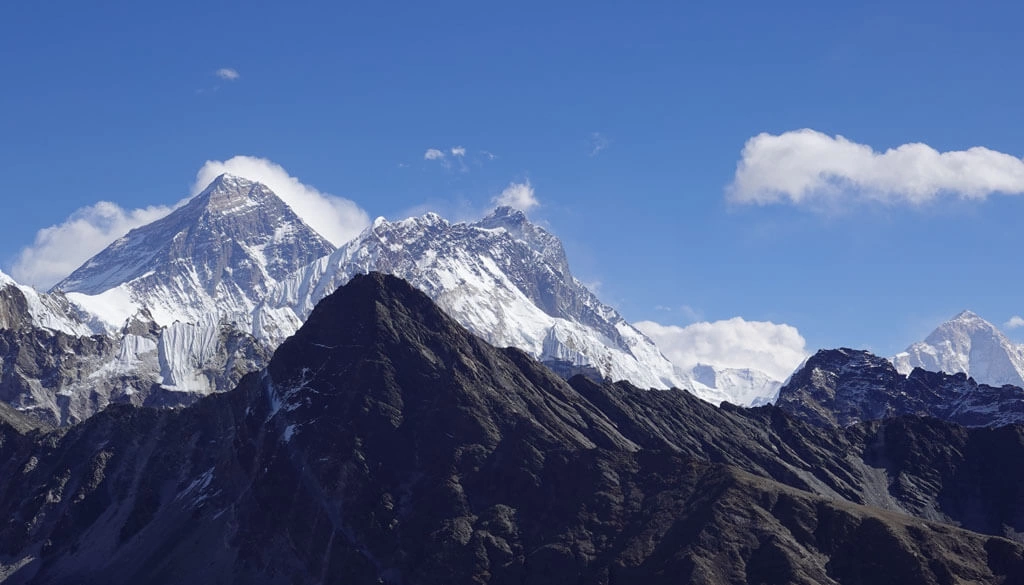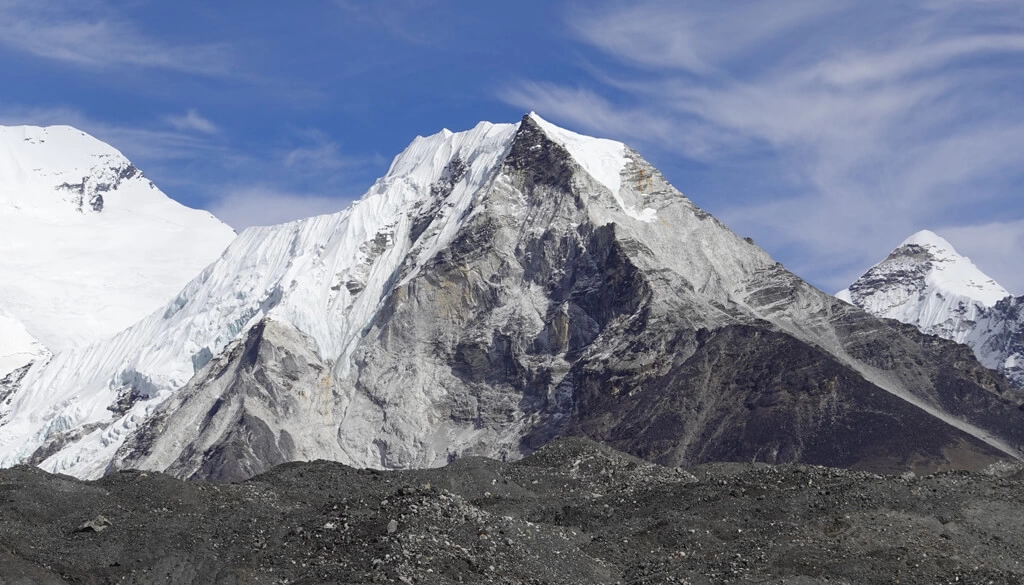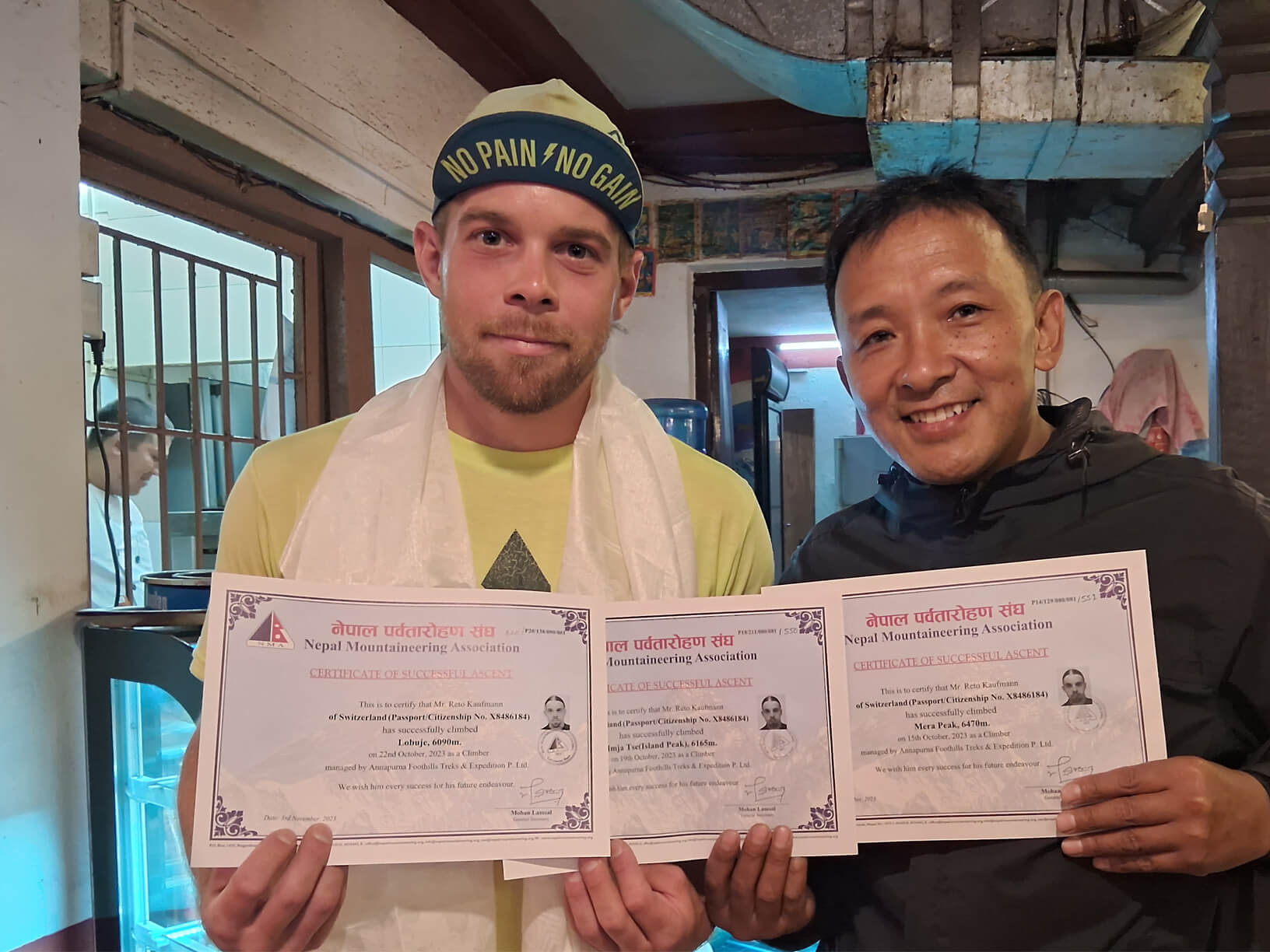About Three Peaks in Everest Region
Three Peaks in Everest Region is a physically and mentally challenging adventure through the Khumbu Valley. Climbing Three Peaks in Everest Region is a great way to experience the beauty and challenge of the Khumbu Himalaya. Our Three Peaks in Everest Region combines three of the highest trekking peaks in Nepal: Mera Peak (6,476 m), Island Peak (6,189 m), and Lobuche East Peak (6,119 m). It is a physically demanding trip but also an enriching experience that takes you through the stunning Khumbu region of Nepal, making this trip an adventure of a lifetime.
Mera Peak is the highest permitted trekking peak in the Everest region and offers stunning views of the surrounding mountains, including Mount Everest (8848.86m). Island Peak (Imja Tse) is one of the most popular trekking peaks in the Khumbu region, well known for its challenging climb, and Lobuche East Peak is one of the most challenging trekking peaks in the Khumbu region, offering panoramic views of the Everest massif.
Mera Peak (6476m / 21,247 ft.)
At an elevation of 6,476 meters, Mera Peak is an excellent pick for those looking for their first climbing experience in the Himalayas of Nepal. It provides an opportunity to explore the untouched beauty of the Everest region while challenging yourself physically and mentally, offering a stimulating yet achievable climbing experience in Nepal Himalaya. The climb to the summit of Mera Peak offers spectacular views of the surrounding mountains, including Mount Everest (8,848.86 m), Mount Lhotse (8,516 m), Mount Cho Oyu (8,201 m), Mount Makalu (8,463 m), and Mount Kanchenjunga (8,586 m).
Island Peak (6189m / 20,305 ft.)
Island Peak (Imja Tse), at 6,189 meters, is an exciting and challenging climb in the Khumbu Himalaya. It is a moderately technical trekking peak in the Everest region of Nepal. However, it is still within reach of the average fit person who wants a genuine high-altitude climbing experience on snow and ice. The climb is graded as 2B in difficulty, requiring some technical skills and experience. The summit of Island Peak offers stunning views of the surrounding mountains, including Everest (8,848.86 m), Nuptse (7,861 m), Lhotse (8,516 m), Ama Dablam (6,812 m), and other snowy peaks.
Lobuche East Peak (6119m / 20,075 ft.)
Challenge yourself with the most demanding and technical trekking peak in the Everest Three Peak Climbing trip: Lobuche East Peak Climbing. Lobuche East Peak, at 6119 meters, is a challenging 6,000-meter mountaineering experience requiring basic rock and ice climbing techniques at high altitudes. The climb is steep and exposed, with some technical sections requiring crampons and ice axes. Climbers must also be acclimatized to the high altitude, which can be a challenge in itself. However, the rewards of summiting Lobuche Peak are great as one can relish the panoramic views of the surrounding peaks, including Mount Everest (8848.86m), Cho Oyu (8188m), and Ama Dablam (6812m).
Three Peaks in Everest Region Route Overview
Our Three Peaks Climbing in Everest Region Expedition begins with a scenic flight from Kathmandu to Lukla. After a short yet spectacular flight to Lukla, we descend to Paiya, where we will spend the first night of our journey. The trail leads through forests down to the traditional villages of Surke and Pakhepani, along with rhododendron forests on the way. The advantage of doing this trek from Paiya is that it allows you enough time to get adequately acclimatized to Khare. From Khare, we begin the climbing part. The route to Mera Peak Base Camp, followed by High Camp, goes via Mera La. Only the last 30 or 40 meters to the summit require fixed lines. From the summit, you get surreal views of the over-8000-meter-mountains including Mt. Everest (8848.86m), Mt. Lhotse (8516m), Mt. Cho Oyu (8201m), Mt. Makalu (8463m), Mt. Kanchenjunga (8586m), to name a few.
Descending from the summit of Mera Peak, the route turns east at the Mera La into the Upper Hongu Valley. Upon reaching Paanch Pokhari (5 Divine Lakes), we prepare ourselves to tackle one of the toughest objectives of the expedition, the Amphu Labsta pass (5700m). The succession of ice steps up to the rocky crest calling for a fixed line. From the top, we have to make a 35-meter abseil to reach fixed ropes for the next 300 meters of steep switchback descent on snow and rock.
After the Amphu Labtsa pass, we re-enter the Khumbu Valley. We will set up a Base Camp in the Imja Valley via Chhukung and prepare to summit Island Peak. We will march towards Island Peak via the standard route, directly beneath the massive southwest face of Lhotse (the fourth-highest mountain in the world). Though lower in altitude than Mera Peak, Island Peak is slightly more technical and challenging. The ascent involves an easy scramble up to a rock ridge and then onto a glacier, where fixed lines are used to climb the 45-degree snow slopes leading to the exposed summit ridge. The panoramic Himalayan view from the Island Peak summit includes Mt. Lhotse, Mt. Nuptse, Makalu and Mt. Ama Dablam. After relishing the view, we'll return to Chhukung Valley and join the Classic Everest Base Camp trail at Dughla (Thukla).
Finally, we head towards our expedition's last but equally challenging objective, i.e., Lobuche Peak. We practice glacier and snow climbing with our Sherpa Climbing Guide while our staff establishes a High Camp at 5400 meters. To reach the summit from High Camp, we cross over steep stone slabs, which may be covered with ice and snow. To reach the proper summit ridge, we have to ascend 50m on a 45-degree snow wall. We use fixed ropes for the climb, and eventually, the sharp snowy ridge to the first summit can be witnessed. There is a descent which you may need to rappel down before the final sharp ascent to the summit. We appreciate the astonishing view of some of the most incredible mountains on earth from the summit.
Returning back to Lukla
After scaling the Three 6000M+ Trekking peaks, we descend back to Lobuche, followed by our trail down to Tengboche, Namche and then Lukla. The descent helps your body adjust gradually to the thicker air at lower altitudes, reducing the risk of altitude-related problems. Upon reaching Lukla, our trip officially comes to an end. Celebration for a successful summit can be done on that evening at Lukla. Three Peak Climbing in Everest Region is an unforgettable experience that will challenge you physically and mentally. It is an excellent opportunity to explore the pristine beauty of the Everest region and to summit three of Nepal's most Popular Trekking Peaks.
Returning to Lukla by Helicopter
Flying on a helicopter to return to Lukla after your Three Peaks Climbing is a great way to end your adventure. Traffic jams are common along the EBC (Everest Base Camp) trekking trail, especially from Pheriche to Lukla, where trekkers and yaks carrying loads converge.The scenic flight offers stunning views of the mountains and can save you a lot of time. Helicopter shuttle service is available from all prominent Sherpa settlements (Pheruche, Lobuche, etc.)
Best Season for Three Peak Climbing in Everest Region
The weather in the Himalayan Region changes regularly, bringing new seasons. Each season brings with it different temperatures, perceptibility, and challenges. Therefore, it is crucial to be aware of the seasons before climbing the Three Peaks in Everest Region.
The best time for the Three Peaks Expedition is Autumn (September to November). The weather is pleasant and stable during this time, with clear skies and low rainfall. Spring (March to May) is also an excellent time to climb, as the weather is similar to autumn. Winter can be a great time to climb if you are well-prepared for the cold weather. The best winter months to climb Mera Peak are early December and late February when the weather is driest and coldest.
Travel Insurance for Three Peaks in Everest Region
Travel insurance is a must to book any adventure activities with Annapurna Foothills Treks, especially while trekking, high passes, climbing and expedition. With that being said, it is clear that Travel insurance is essential for adventure activities like climbing Three Peaks in Everest Region. Your Travel Insurance should cover emergency evacuation, injury, lost baggage, liability, and medical treatment. Helicopter rescue is often the only way to evacuate people from the mountains in case of accidents or high-altitude sickness. It is crucial to have travel insurance that covers the cost of helicopter rescue, as well as ground evacuation and rescue. Annapurna Foothills Treks and Expeditions Pvt. Ltd. can organize the appropriate medical response based on your policy. Click here for more detail about Travel Insurance.
We have carefully planned and designed the Three Peaks in Everest Region Expedition Itinerary, which allows adequate acclimatization days for climbers and practical mountaineering coaching with our experienced Local Sherpa Guides. A well-managed logistics and a highly experienced, qualified, and cheerful Sherpa Team awaits you in the lap of the Khumbu Himalaya. Hurry up and book your slot.
Booking is Open for 2025 / 2026


















